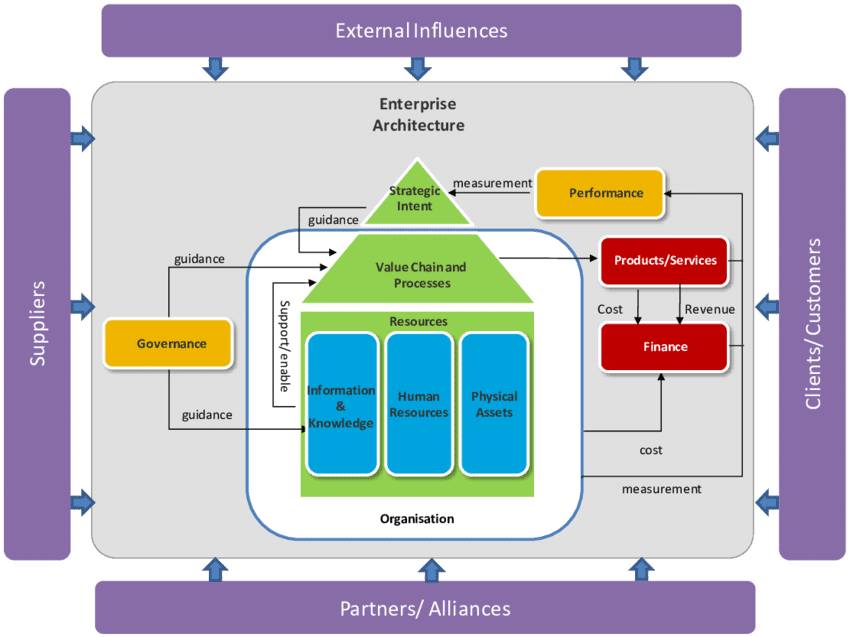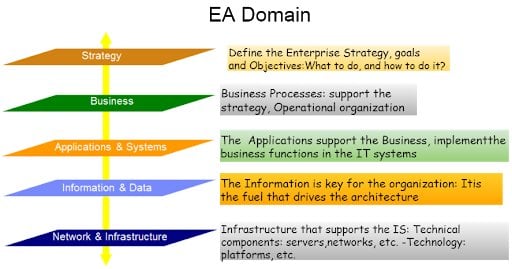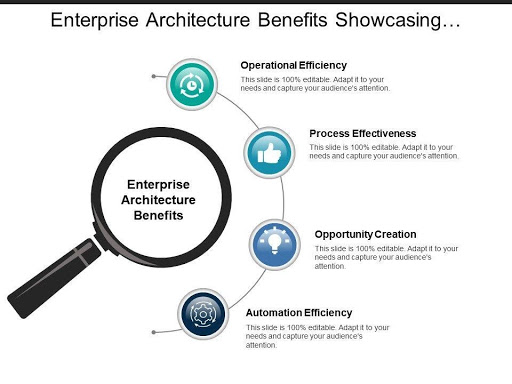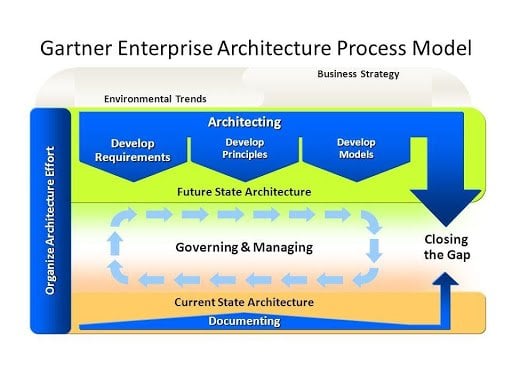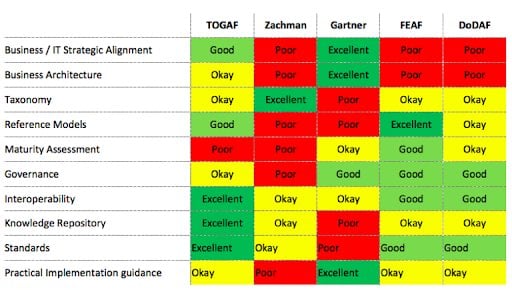The Enterprise Architecture for Continuing Professional Education: A Quick Guide
What is Enterprise Architecture (EA)?
Enterprise architecture is defined as a process of analyzing, designing, planning, and executing enterprise analysis to implement business strategies. EA strategies support digital transformation, IT growth, and innovate the IT department. That way, EA facilitates business structure IT projects and policies to accomplish business results. To stay on top of the industry trends and disruptions using principles and practices of architecture, enterprise architectural planning (EAP) is an indispensable aspect for organizations.
The practice of EA dates back to the 1960s. The term was coined by Professor Dewey Walker from “various architectural manuscripts on Business Systems Planning (BSP),” as per Enterprise Architecture Book of Knowledge (EABOK). One of his students, John Zachmann played an essential role in formulating the concept and documenting it into a structured format of EA. They both worked for IBM at that time. In 1987, the framework was published in IBM Systems Journal.
Back in the 1980s when computer systems had just started getting used at workplaces and there was a need for business technology (such as supporting APIs for digital transformations), the EA framework came as a response. This was the time when companies started to realize that they needed a plan and a long-term strategy to support and leverage the rapid growth of technology. Even now, this remains true.
Today, modern EA strategies are designed to encapsulate this philosophy to the entire business and not just IT. The goal is to ensure that a business is aligned with digital transformation and technological growth. Bringing legacy procedures and applications together forms a seamless environment to drive ahead success.
What are the Goals of Enterprise Architecture?
EA is funneled by a business’ requirements. It bridges and combines the gaps and opportunities in information, business, and technology. This has become significant for organizations that are looking to stay abreast of new technologies. IoT, cloud, artificial intelligence, machine learning, and other emerging developments. In an ever-evolving technology landscape, prompt digital transformations are crucial.
The original philosophy from EABOK is relevant even today. The messaging is summed up as, “The framework combines people, data and technology to effectively build inter-relationships within an information technology organization.”
As per EABOK, the process is determined taking into the picture the perspectives of the owner, designer, and builder. This framework did not have a formal documented structure. Instead, it could be designed based on the enterprise for a holistic view.
Today, a good EAP strategy takes into consideration recent innovations in business procedures, company structure, information systems, and technologies. That entails understanding best practices for business developments, analyzing the applications, and integrations of these processes throughout the organization. The ultimate objective of every enterprise architecture strategy is to improve efficiency, timeliness, and consistency of business information.
What are the Benefits of Enterprise Architecture?
During major organizational changes, mergers, acquisitions, EA gives support for re-designs and re-organizations. When you consolidate and standardize processes for more consistency, it brings added discipline into the organization.
EA is used in multiple branches such as system development, IT management, and decision-making. The role also extends to IT risk management to do away with errors, system failures, and security breaches. To make IT more accessible to every department and navigate complex IT structures, EA comes in handy.
The biggest benefits of EA in an organization include:
- Enabling collaboration between IT and other business sectors
- Giving an organization the ability to streamline their investments
- Establishing a process to measure and evaluate existing architecture and new technologies needed for long-term goals
- Setting up practices to evaluate and acquire technology
- Enabling all business units to view the IT architecture (including that outside of IT)
- Creating a benchmark framework where one can compare results with other organizations
These benefits highlight that all modern businesses require EA. A structured framework allows you to have full control of your assets. In the case of escalating complexities in the business environment, they can be immediately tackled.
EA in the present times represents a methodology that designs, improves, and maintains IT infrastructure. This can be visualized, described, replicated, and adopted by organizations, regardless of their size and industry. With the slew of proven benefits, you cannot miss out on equipping an organization with the concepts and practices for success.
Different Enterprise Architecture Methods
In absence of a framework, any concept can be vague. Likewise, enterprise architecture has several frameworks that can be replicated across business units and the entire organization.
The four leading EA methodologies are:
- TOGAF (The Open Group Architectural Framework) – Adopted by 80% of the world’s leading enterprises, the TOGAF framework is one of the most popular approaches to EA. The principles for designing, planning, executing, and governing enterprise IT architecture create a standardized process. There are several tools, practices, software and compliance methods to define best practices.
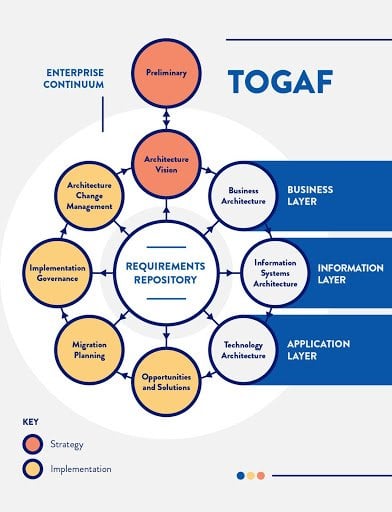
- Zachman Framework for Enterprise Architecture – Named after the founders of EA, the Zachman framework is a popular method of EA. Also called “taxonomy”, it has six architectural focal points to standardize and define IT components and outputs.
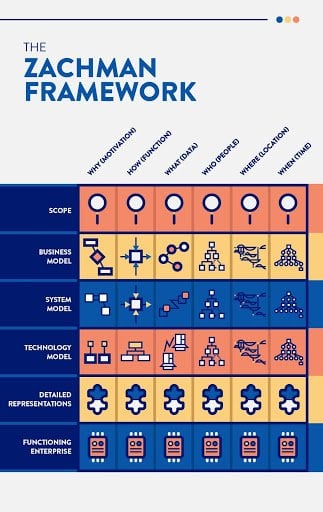
- FEAF (Federal Enterprise Architecture Framework) – Primarily designed for the US government, FEAF has mandated IT effectiveness in federal agencies. Created in 1996 in response to the Clinger-Cohen Act, this method of EA can be applied to private companies who want to use it.
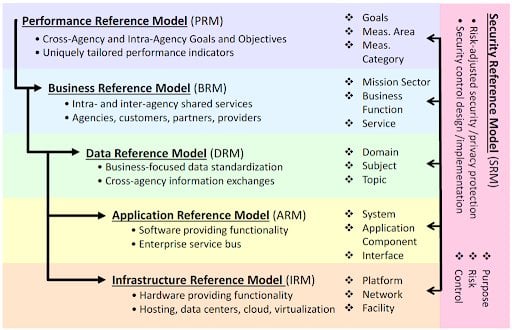
Source: Wikipedia
- Gartner – Post-acquisition of The Meta Group in 2005, Gartner adopted EA into the general consulting practices. Although not an individual framework, this practical methodology targets to accomplish business outcomes in a few explicit steps.
These are generalized EA methodologies. Along with these four most commonly applied and recognized EA methods, others include ESAAF (European Space Agency Architectural Framework), MODAF (Ministry of Defence Architecture Framework), and SAP Enterprise EAF. They target specific industries, products, and a niche market.
What is the Role of an Enterprise Architect?
EA, who develop long-term IT strategies for companies to support business strategies report to either CIO or IT managers. They analyze business structures, provide technology and applications roadmap, and see that they align with the organization’s goals. As an enterprise architect, you are responsible for directing, steering, and ensuring that the technology structures and processes are agile to swiftly adapt to changes. The role entails defining every part of the technology flow so that IT and IT-processes run smoothly, efficiently, and effectively from start to finish.
From a bigger perspective, they are people responsible for ensuring that different areas of technological infrastructure work within the defined process. Starting from security and data to servers, networks, and hardware, and EA has to be knowledgeable about every aspect of the IT infrastructure.
As per Payscale, the average salary of an Enterprise Architect in IT is INR 2,619,045.
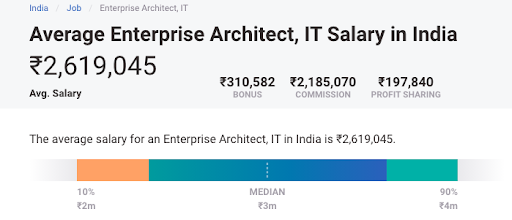
The future job scope for an EA in IT is working as a CTO, software engineer, development director, or Chief Information Officer (CIO).
As per LinkedIn, the open job positions for enterprise architects in India are:

An EA is required to have robust technical skills as well as critical soft skills. Leadership abilities, the capability to communicate with all IT and management stakeholders, and good interpersonal skills set the best enterprise architects apart.
How can you become an Enterprise Architect?
To become an enterprise architect, you would need experience working with computer systems, hard drives, and other technologies. Software skills include problem-solving, leadership, teamwork and communication.
You can take different paths to reach the position of an EA. You can start by participating in meetings and volunteering for committees at your workplace. When you take an initiative to learn different aspects of technology at your organization, it improves the breadth of your knowledge and IT know-how. Understand the business domain your company operates in and the technological advances taking place.
For example, if you are a business analyst (BA), learn about cloud computing and programming. This way, you will gain a clear understanding of how the IT departments function.
What are the Job Roles and Enterprise Architect Performs?
- Understanding security requirements and threats at different levels of the organization.
- Reviewing the security architect framework and suggesting modifications and changes.
- Constantly monitoring security systems and conducting regular systems tests. Carrying out network tests.
- Predicting possible threats and identifying sources of weakness.
- Establishing access control based on the requirements and roles.
- Upgrading IT systems regularly.
- Anticipating security attacks, breaches, and promptly responding to possible to them.
- Conducting frequent security drills and establishing disaster control and recovery processes.
Skills required to become a successful Enterprise Architect
Being an EA in the IT industry requires a combination of technical and soft skills. They include:
- Problem interpretation – Defining the resolution of a problem by finding out the real issues that need to be addressed. Additional variables and relationships affecting the outcome also need to be considered.
- Problem-solving and shaping solutions – Following the art of possibilities to find solutions that address the queries. That includes analyses, troubleshooting, research, evaluation, and communicating the issues.
- Verbal and written communication skills – An enterprise architect has to communicate the problem and solution for processes that require intervention.
- Converting proposed solutions into actions – To effectively address known and potential issues, the EA must be skilled in creating a proposal. This involves communicating with stakeholders during the development, testing, and deployment.
- Solution management – Managing the proposed solution at every stage of the lifecycle. Right from updating stakeholders, setting up budgets to evaluating the applications.
- Leadership – An EA has to coordinate with the IT team and other departments. Strong leadership skills enable managing and empowering team members to remain on task, stay motivated, and ensure timely delivery.
Enterprise architecture is a job that has immense potential and high demand in the market. This is the right time to upskill yourself to become an EA. You deliver a deep-impact value by proactively and holistically leading the business outcomes by capitalizing on the latest technology disruptions.
